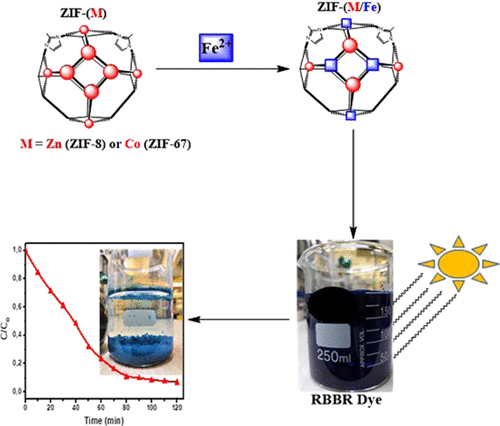Our official English website, www.x-mol.net, welcomes your
feedback! (Note: you will need to create a separate account there.)
Metal Exchange of ZIF-8 and ZIF-67 Nanoparticles with Fe(II) for Enhanced Photocatalytic Performance
ACS Omega ( IF 3.7 ) Pub Date : 2021-11-15 , DOI: 10.1021/acsomega.1c04142 Lehlohonolo E Mphuthi 1 , Elizabeth Erasmus 1 , Ernst H G Langner 1
ACS Omega ( IF 3.7 ) Pub Date : 2021-11-15 , DOI: 10.1021/acsomega.1c04142 Lehlohonolo E Mphuthi 1 , Elizabeth Erasmus 1 , Ernst H G Langner 1
Affiliation

|
Zeolitic imidazolate frameworks (ZIFs), such as ZIF-8 and ZIF-67, were found to be efficient catalysts. However, ZIFs are not used much in photocatalysis due to their low photocatalytic activity for most reactions. The photocatalytic activity can be improved by modifying the framework by exchanging the Zn(II) ions (ZIF-8) and Co(II) ions (ZIF-67) with a more photocatalytically active metal(II) ion to form an efficient bimetallic ZIF photocatalyst. Redox-active iron (Fe)-based materials are known to be highly potent photocatalysts. Thus, incorporating iron into ZIFs could significantly enhance their photocatalytic performance. In this study, we modified nanosized ZIF-8(Zn) and ZIF-67(Co) via metal (Fe2+) exchange to produce bimetallic frameworks that are photocatalytically more active than their parent ZIFs. Nanosized ZIF-8 and ZIF-67 were synthesized isothermally in either water or methanol under ambient conditions. From these, Fe-containing bimetallic ZIF-8 and ZIF-67 nanoparticles were synthesized via the metal exchange, and their performance on the photocatalytic degradation of dye was evaluated. The morphology and crystal structures of the pristine ZIF-8 and ZIF-67 nanoparticles were retained to a large extent during the iron exchange. Their Brunauer–Emmett–Teller (BET) surface areas decreased by less than 15% for nZIF-8 and less than 12% for nZIF-67. The binding energy values on X-ray photoelectron spectroscopy (XPS) confirmed the preservation of the oxidation state of Fe(II) during the exchange process. A remarkably higher catalytic activity was observed for the photocatalytic degradation of dye by the Fe-exchanged nZIF-8 and nZIF-67 compared to their parent ZIFs. This proved that the incorporation of Fe(II) centers into the ZIF framework enhanced the photocatalytic activity of the framework dramatically. In addition, these catalysts can be regenerated and reused without an appreciable loss in activity.
中文翻译:

ZIF-8 和 ZIF-67 纳米颗粒与 Fe(II) 的金属交换以提高光催化性能
沸石咪唑酯骨架 (ZIF),例如 ZIF-8 和 ZIF-67,被发现是有效的催化剂。然而,由于 ZIF 对大多数反应的光催化活性较低,因此在光催化中的应用并不多。通过将 Zn(II) 离子 (ZIF-8) 和 Co(II) 离子 (ZIF-67) 与更具光催化活性的金属 (II) 离子交换以形成有效的双金属 ZIF 来修饰骨架,可以提高光催化活性光触媒。已知氧化还原活性铁 (Fe) 基材料是高效的光催化剂。因此,将铁加入 ZIF 可以显着提高其光催化性能。在本研究中,我们通过金属 (Fe 2+) 交换以产生比其母体 ZIF 具有更高光催化活性的双金属框架。在环境条件下,在水或甲醇中等温合成纳米尺寸的 ZIF-8 和 ZIF-67。从中,通过金属交换合成了含铁的双金属 ZIF-8 和 ZIF-67 纳米粒子,并评估了它们对染料光催化降解的性能。在铁交换过程中,原始 ZIF-8 和 ZIF-67 纳米颗粒的形态和晶体结构在很大程度上得以保留。他们的 Brunauer-Emmett-Teller (BET) 表面积对于 nZIF-8 下降了不到 15%,对于 nZIF-67 下降了不到 12%。X 射线光电子能谱 (XPS) 上的结合能值证实了在交换过程中 Fe(II) 氧化态的保持。与它们的母体 ZIF 相比,Fe 交换的 nZIF-8 和 nZIF-67 对染料的光催化降解具有显着更高的催化活性。这证明将 Fe(II) 中心掺入 ZIF 框架显着增强了框架的光催化活性。此外,这些催化剂可以再生和重复使用,而不会显着降低活性。
更新日期:2021-11-30
中文翻译:

ZIF-8 和 ZIF-67 纳米颗粒与 Fe(II) 的金属交换以提高光催化性能
沸石咪唑酯骨架 (ZIF),例如 ZIF-8 和 ZIF-67,被发现是有效的催化剂。然而,由于 ZIF 对大多数反应的光催化活性较低,因此在光催化中的应用并不多。通过将 Zn(II) 离子 (ZIF-8) 和 Co(II) 离子 (ZIF-67) 与更具光催化活性的金属 (II) 离子交换以形成有效的双金属 ZIF 来修饰骨架,可以提高光催化活性光触媒。已知氧化还原活性铁 (Fe) 基材料是高效的光催化剂。因此,将铁加入 ZIF 可以显着提高其光催化性能。在本研究中,我们通过金属 (Fe 2+) 交换以产生比其母体 ZIF 具有更高光催化活性的双金属框架。在环境条件下,在水或甲醇中等温合成纳米尺寸的 ZIF-8 和 ZIF-67。从中,通过金属交换合成了含铁的双金属 ZIF-8 和 ZIF-67 纳米粒子,并评估了它们对染料光催化降解的性能。在铁交换过程中,原始 ZIF-8 和 ZIF-67 纳米颗粒的形态和晶体结构在很大程度上得以保留。他们的 Brunauer-Emmett-Teller (BET) 表面积对于 nZIF-8 下降了不到 15%,对于 nZIF-67 下降了不到 12%。X 射线光电子能谱 (XPS) 上的结合能值证实了在交换过程中 Fe(II) 氧化态的保持。与它们的母体 ZIF 相比,Fe 交换的 nZIF-8 和 nZIF-67 对染料的光催化降解具有显着更高的催化活性。这证明将 Fe(II) 中心掺入 ZIF 框架显着增强了框架的光催化活性。此外,这些催化剂可以再生和重复使用,而不会显着降低活性。


















































 京公网安备 11010802027423号
京公网安备 11010802027423号